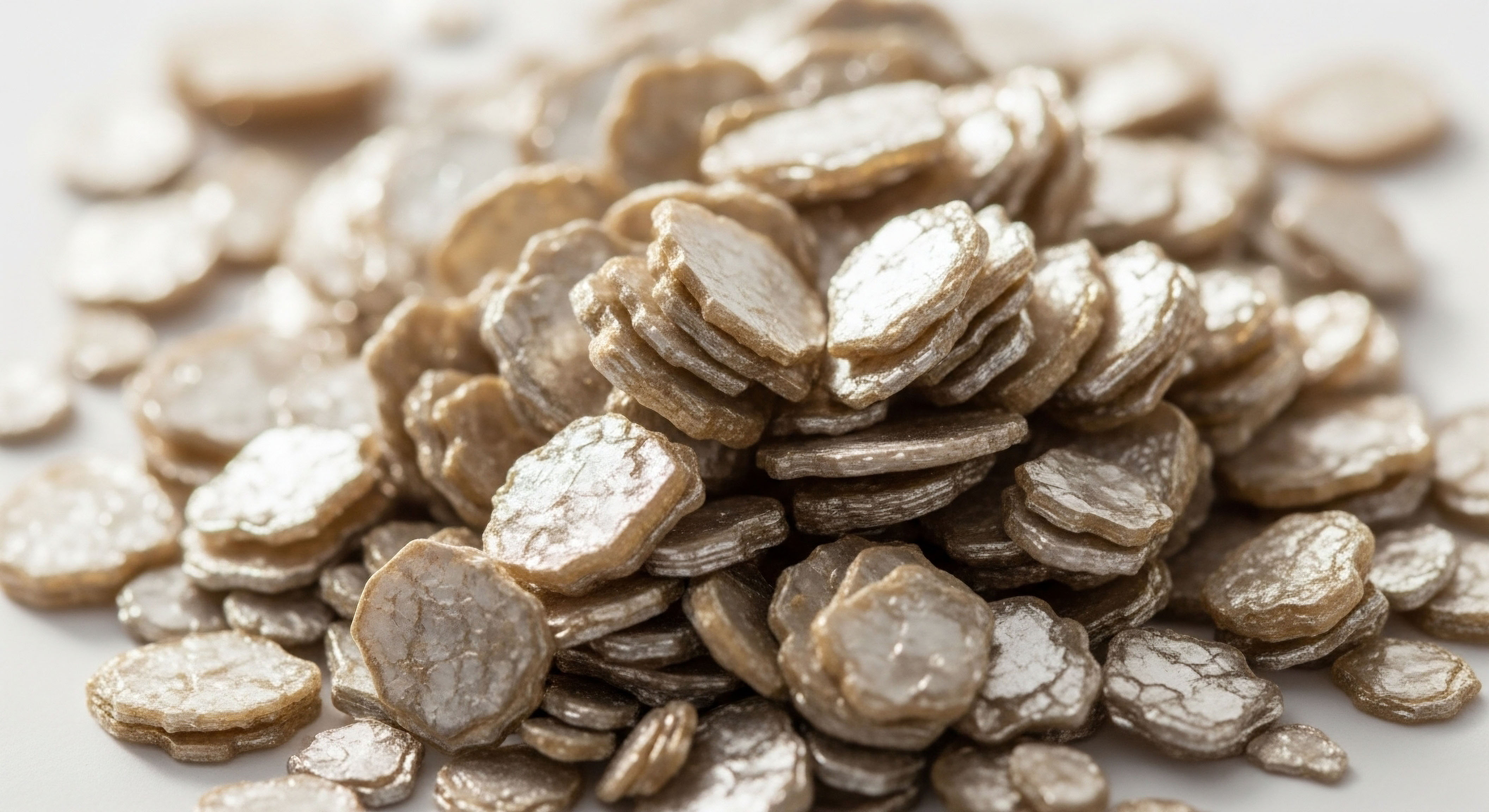

Fundamentals
You may be looking at your own health, feeling that there is a level of vitality that remains just out of reach, and wondering if ancient traditions hold a key that modern science is only now beginning to understand. Your intuition is pointing toward a profound biological reality.
When we speak of Traditional Chinese Medicine (TCM), we are referencing a system of healing that has, for millennia, cataloged the effects of specific herbs, minerals, and animal-derived substances on the human body. The system is built on concepts like Qi and Jing, which describe the body’s vital energy and essence.
From a modern scientific perspective, we can begin to translate these concepts by examining the molecular components of these traditional remedies. Many of these substances are rich in proteins, and within those proteins lie the very molecules that drive much of our own physiology ∞ peptides.
A peptide is a short chain of amino acids, the fundamental building blocks of protein. Think of them as precise biological messengers, carrying specific instructions from one part of the body to another. Their structure is their function; each unique sequence is a key designed to fit a specific lock, or receptor, on the surface of a cell.
When a peptide binds to its receptor, it initiates a cascade of events inside that cell, instructing it to perform a particular action. This could be anything from reducing inflammation to stimulating tissue repair or modulating the release of a hormone. Your body produces thousands of these peptides naturally.
They are the language of cellular communication, the operational signals that maintain the intricate balance of your biological systems. The feeling of wellness, of robust energy and function, is in large part a reflection of this communication network operating with precision and efficiency.
A peptide is a biological messenger that carries specific instructions to cells, influencing functions like tissue repair and hormonal regulation.
The core insight here is that certain revered materials within the TCM pharmacopoeia, such as Cordyceps fungus or donkey-hide gelatin (Ejiao), are exceptionally dense sources of proteins and their constituent peptides. The traditional methods of preparing these substances, often involving slow cooking or specific extraction processes, are, in effect, rudimentary ways of breaking down large proteins into these smaller, bioactive peptide fragments.
This makes them more available for the body to absorb and utilize. Therefore, when we ask if TCM can offer an alternative access point to peptides, we are building a bridge between ancient observational wisdom and contemporary molecular biology.
We are recognizing that the documented effects of these traditional substances may be explained, in significant part, by the actions of these powerful signaling molecules on our own cellular machinery. Understanding this connection is the first step in appreciating how these ancient pathways can inform a modern, personalized approach to reclaiming and optimizing your health.

The Language of Cellular Function
To truly grasp the significance of peptides, it is helpful to visualize your body as a vast and complex communication network. Every cell is both a transmitter and a receiver of information. Hormones, which are often large molecules, can be thought of as system-wide broadcasts, affecting many different tissues at once.
Peptides, being smaller and often more targeted, act more like direct messages sent to specific recipients. They are the agents of precision. For instance, while Human Growth Hormone (HGH) is a large protein that signals for growth and repair globally, a peptide like Sermorelin works one step up the chain.
Sermorelin signals the pituitary gland to produce and release its own HGH, representing a more nuanced and regulatory approach to influencing the system. This principle of precise signaling is central to their therapeutic potential.
This is where the lived experience of symptoms connects directly to biology. Feelings of fatigue, slow recovery, cognitive fog, or a decline in physical performance are often outward signs of compromised cellular communication. The signals are not being sent with the right frequency or intensity, or the cellular “receivers” are not as sensitive as they once were.
Introducing specific peptides, whether synthesized in a modern lab or derived from a traditional source, is an intervention aimed at restoring the clarity and efficiency of this internal dialogue. It is about providing the specific “words” the body needs to initiate its own inherent processes of healing, regeneration, and optimization. The access point, whether a modern syringe or a traditional decoction, is simply the delivery mechanism for these fundamental biological instructions.

From Natural Source to Biological Action
The journey of a peptide from a TCM source to a cell in your body involves several critical steps. First, the source material itself must contain the necessary proteins. Then, these proteins must be broken down, a process known as hydrolysis. In traditional preparations, this might happen through prolonged heating in water.
In a modern context, scientists use specific enzymes to cleave the proteins at precise points, a method called enzymatic hydrolysis, which is highly efficient at liberating bioactive peptides. Once ingested, these peptides must survive the acidic environment of the stomach and then pass through the intestinal wall to enter the bloodstream. This journey, known as bioavailability, is a key factor in the efficacy of any orally consumed peptide.
Once in circulation, the peptide travels throughout the body until it finds its matching cellular receptor. The binding event triggers the intended biological response. For example, certain peptides derived from TCM sources have been shown to have antioxidant properties. This means they can help neutralize free radicals, unstable molecules that cause cellular damage and contribute to aging.
Other peptides demonstrate anti-inflammatory or immunomodulatory effects, helping to calm an overactive immune response. This is the essence of the connection ∞ the observable, holistic effects described in TCM texts for centuries are being mapped to specific, measurable molecular actions. The pathway is ancient, but the mechanism is pure biochemistry.


Intermediate
Advancing from the foundational understanding that Traditional Chinese Medicine can be a source of bioactive peptides, we can now examine the specific types of peptides identified and the mechanisms by which they exert their influence. The investigation moves from the general concept to the particular molecule.
Scientific analysis of traditional materials reveals a host of peptides with distinct biological activities, aligning remarkably well with the historical uses of their source materials. This alignment provides a powerful validation of the idea that TCM’s efficacy is, in many cases, rooted in a sophisticated, naturally derived molecular pharmacology. The focus shifts to classification, preparation, and the biological pathways these molecules engage once they are made accessible to the body.
The primary method for liberating these peptides from their parent proteins is enzymatic hydrolysis. This process uses specific enzymes to act as molecular scissors, cutting large protein chains into smaller, defined peptide fragments. This is a more controlled and efficient evolution of traditional methods like boiling or stewing.
After liberation, these peptides can be categorized based on their observed effects in laboratory studies. These effects are not random; they are a direct consequence of the peptide’s unique amino acid sequence, which dictates which cellular receptors it can bind to and activate. This specificity is the key to their potential for targeted therapeutic applications, moving beyond general wellness to address specific physiological imbalances.
The process of enzymatic hydrolysis efficiently liberates specific bioactive peptides from proteins found in traditional medicinal sources.

A Catalog of Bioactive Peptides from TCM Sources
Research has identified several classes of functional peptides within materials used in TCM. Understanding these categories allows for a more precise appreciation of how these ancient remedies might function at a cellular level. The variety of functions speaks to the complexity of these natural sources, which can contain a multitude of different peptide sequences, each with a unique role.
Here is a breakdown of some of the key types of bioactive peptides that have been isolated from traditional Chinese medicinal and food sources:
- Antioxidant Peptides ∞ These molecules are crucial for cellular protection. They function by donating electrons to neutralize reactive oxygen species (ROS), or free radicals. Unchecked, ROS can damage DNA, proteins, and cell membranes, accelerating the aging process and contributing to chronic disease. Peptides with antioxidant activity have been identified in sources like Cordyceps and red deer antlers, materials long associated in TCM with longevity and vitality.
- Antihypertensive Peptides ∞ A number of peptides function as natural ACE (Angiotensin-Converting Enzyme) inhibitors. ACE is an enzyme that plays a key role in the renin-angiotensin system, a hormonal cascade that regulates blood pressure. By inhibiting this enzyme, these peptides help to relax blood vessels and lower blood pressure. This provides a direct molecular explanation for the cardiovascular benefits attributed to certain traditional formulas.
- Anti-inflammatory Peptides ∞ Chronic inflammation is a driver of nearly every major age-related disease. Certain peptides derived from TCM sources can modulate the body’s inflammatory response. They may work by inhibiting pro-inflammatory signaling pathways like NF-κB or by promoting the polarization of macrophages towards an anti-inflammatory M2 state. Peptides from sources like Anoectochilus formosanus have demonstrated these effects.
- Immunomodulatory Peptides ∞ The immune system requires a delicate balance. Some peptides can enhance immune surveillance, helping the body identify and eliminate pathogens or abnormal cells. Others can help to suppress autoimmune responses where the body mistakenly attacks its own tissues. Peptides from ginseng and other adaptogenic herbs often fall into this category, reflecting their traditional use as systemic balancers.
- Antimicrobial Peptides ∞ In an era of growing antibiotic resistance, there is intense interest in new antimicrobial agents. Some TCM-derived peptides have shown the ability to directly kill or inhibit the growth of pathogenic bacteria and fungi. They often work by disrupting the integrity of the microbial cell membrane, a mechanism that is difficult for microbes to develop resistance to.

How Are TCM Peptides Made Bioavailable for Clinical Use?
The practical application of these peptides hinges on their bioavailability. A peptide may show potent activity in a petri dish, but it must be able to reach its target tissues in the body to be effective. This presents a significant challenge for oral administration, as the digestive system is designed to break proteins and peptides down into individual amino acids for absorption.
While some small oligopeptides can be absorbed intact, the journey is precarious. This is why modern peptide therapies, such as Ipamorelin or BPC-157, are typically administered via subcutaneous injection, bypassing the digestive tract entirely.
For TCM-derived peptides, the pathway to clinical relevance involves several potential routes:
- Optimized Oral Formulations ∞ Research is underway to develop delivery systems that can protect peptides from degradation in the stomach and enhance their absorption in the intestine. This might involve encapsulating them in liposomes or other protective coatings.
- Extraction and Purification for Injection ∞ A more direct approach involves identifying the most potent bioactive peptide within a traditional source, synthesizing it in a laboratory, and administering it as a targeted, injectable therapy. This removes the variability of the natural source and ensures a precise, clinical dose.
- Topical or Transdermal Delivery ∞ For some applications, such as skin health or localized tissue repair, peptides can be incorporated into creams or patches that allow them to be absorbed through the skin, bypassing the gut.
The table below contrasts the traditional pathway with modern pharmacological approaches, highlighting the evolution in accessing these molecules.
| Attribute | Traditional TCM Pathway | Modern Pharmacological Pathway |
|---|---|---|
| Source | Whole natural products (e.g. herbs, fungi, animal parts) containing a complex mixture of molecules. | Isolated and synthesized single peptide molecules with a known, pure structure. |
| Liberation Method | Primarily decoction (prolonged heating in water) or fermentation. | Controlled enzymatic hydrolysis or direct chemical synthesis. |
| Composition | A “soup” of many different peptides, polysaccharides, and other compounds. Synergistic effects are possible. | A single, highly purified peptide at a precise concentration. |
| Administration | Almost exclusively oral (teas, powders, pills). | Typically subcutaneous injection, bypassing the digestive system for maximal bioavailability. |
| Dosage | Variable and difficult to standardize due to natural variations in the source material. | Precise, consistent, and clinically validated dosage. |
| Mechanism | Effects are the result of the combined action of many compounds on multiple biological pathways. | Effect is the result of a specific molecule binding to a specific receptor to trigger a known pathway. |


Academic
An academic exploration of peptides from Traditional Chinese Medicine requires a shift in perspective from cataloging potential activities to deconstructing the precise molecular mechanisms and addressing the formidable challenges of clinical translation. The central inquiry becomes ∞ can the pharmacodynamic basis of certain TCM interventions be mapped directly to the signaling functions of specific peptide constituents?
This pursuit moves beyond the simple identification of bioactive molecules and into the realms of pharmacology, systems biology, and regulatory science. It necessitates viewing traditional preparations as complex biological systems, whose holistic effects arise from the interplay of numerous molecules, with peptides acting as key signaling hubs within that system.
The dominant scientific paradigm for this investigation is one of reductionism followed by reintegration. The first step is to isolate a single peptide from a source material, such as Cordyceps sinensis, and characterize its structure and in-vitro activity. For example, the cyclopeptides cordyceamides A and B have been identified from this fungus.
The subsequent, more complex step is to understand how this isolated molecule functions within the context of the whole organism. This involves studying its pharmacokinetics (absorption, distribution, metabolism, excretion) and its pharmacodynamics (the biochemical and physiological effects on the body). It also requires placing its action within the broader context of the body’s own signaling networks, such as the Hypothalamic-Pituitary-Gonadal (HPG) axis or the neuroendocrine-immune system, to understand its systemic impact.

What Are the Regulatory Hurdles for TCM Peptide Commercialization?
The path from a promising peptide identified in a TCM source to a clinically approved therapeutic is fraught with significant regulatory and scientific challenges. Western regulatory bodies, such as the FDA and EMA, are built upon a single-molecule, single-target framework. A drug is expected to be a highly purified chemical entity with a well-defined mechanism of action and a predictable dose-response relationship. Traditional Chinese Medicines, as complex mixtures, defy this paradigm.
A company seeking to commercialize a TCM-derived peptide faces a critical choice. It could pursue approval for the entire complex mixture, which is an arduous process requiring extensive characterization of all components and demonstrating batch-to-batch consistency, a near-insurmountable task for natural products.
The alternative is to adopt the pharmaceutical model ∞ identify the single most active peptide in the mixture, synthesize it to clinical purity, and advance it through the standard drug development pipeline. While scientifically more straightforward, this approach loses the potential synergistic effects of the original mixture and detaches the final product from its traditional roots. This bifurcation of strategy represents the central tension in modernizing natural product pharmacology.
The translation of TCM-derived peptides into approved therapies requires navigating the conflict between traditional holistic preparations and the single-molecule focus of modern drug regulation.

Case Study the Molecular Basis of a TCM Longevity Tonic
Let us consider a hypothetical deep dive into a material like donkey-hide gelatin (Colla Corii Asini or Ejiao), a substance used in TCM to “nourish the blood” and “enrich Yin,” often associated with treating anemia, improving complexion, and promoting vitality. From a biochemical standpoint, Ejiao is produced by stewing donkey skin, resulting in a product rich in collagen and its breakdown products. Collagen is a protein, and its hydrolysis yields a vast array of peptides.
A modern research program would approach this as follows:
- Proteomic Analysis ∞ The first step is to use mass spectrometry to identify the full spectrum of peptides present in a standardized preparation of Ejiao. This would likely reveal thousands of different peptide sequences.
- Bioinformatic Screening ∞ These sequences would then be screened using computer models to predict their potential biological activities. The software would look for sequences similar to known bioactive peptides, such as those that bind to opioid receptors (for pain relief), ACE receptors (for blood pressure), or those that stimulate fibroblast proliferation (for skin health and wound healing).
- In-Vitro Validation ∞ The most promising candidate peptides identified in the screening would be synthesized and tested in cell cultures. For example, a peptide suspected of promoting red blood cell production would be applied to hematopoietic stem cells to see if it stimulates their differentiation.
- In-Vivo Animal Models ∞ Peptides that show success in-vitro would then be tested in animal models of specific conditions, such as anemia or skin aging, to confirm their efficacy and assess their safety and bioavailability in a living system.
This systematic process allows for the deconstruction of a traditional remedy’s perceived effects into the measurable actions of its constituent molecules. It provides a concrete bridge between the language of TCM (“nourishing blood”) and the language of modern physiology (“stimulating erythropoiesis”).
The table below outlines the research cascade for validating a peptide from a TCM source.
| Phase | Objective | Key Methodologies | Potential Outcome |
|---|---|---|---|
| Phase 1 Discovery | Identify all potential bioactive peptides within the source material. | Enzymatic Hydrolysis, High-Performance Liquid Chromatography (HPLC), Mass Spectrometry. | A complete library of peptide sequences present in the TCM preparation. |
| Phase 2 Screening | Predict the biological function of the identified peptides. | Bioinformatic analysis, sequence homology comparison with known peptide databases. | A shortlist of high-potential peptides for further testing. |
| Phase 3 In-Vitro Validation | Confirm the predicted biological activity in a controlled lab setting. | Cell culture assays, receptor binding studies, gene expression analysis (e.g. qPCR). | Proof-of-concept that a specific peptide has a desired cellular effect. |
| Phase 4 In-Vivo Confirmation | Verify the peptide’s efficacy and safety in a living organism. | Administration to animal models of disease, pharmacokinetic studies, toxicological analysis. | Data supporting the peptide’s potential as a therapeutic agent in a whole-body system. |
| Phase 5 Clinical Trials | Evaluate the safety and efficacy of the synthesized peptide in humans. | Phase I, II, and III human clinical trials following strict regulatory protocols. | An approved, peptide-based pharmaceutical derived from a traditional source. |

References
- Liu, Min, et al. “Bioactive peptides derived from traditional Chinese medicine and traditional Chinese food ∞ A review.” Food Research International, vol. 89, pt. 1, 2016, pp. 63-73.
- Zhang, Wen-Jing, et al. “Pharmacodynamic material basis of traditional Chinese medicine based on biomacromolecules ∞ a review.” Plant Methods, vol. 16, no. 26, 2020.
- Wang, Chen, et al. “The Research Progress of Bioactive Peptides Derived from Traditional Natural Products in China.” Molecules, vol. 28, no. 14, 2023, p. 5470.
- “Bioactive peptides derived from traditional Chinese medicine and traditional Chinese food ∞ A review.” Sci-Hub, 2016..
- Chen, Lin, et al. “The role of IL-37 and IL-38 in rheumatoid arthritis, the potential clinical applications in precision medicine.” Frontiers in Immunology, vol. 15, 2024.

Reflection

Bridging Ancient Wisdom and Future Physiology
The information presented here represents a confluence of two powerful systems of knowledge ∞ one born from millennia of careful human observation, and the other from the rigorous, mechanistic inquiry of modern science. The recognition of bioactive peptides within traditional remedies does not diminish the holistic philosophy of TCM.
It provides a new language, a molecular grammar, through which we can appreciate its mechanisms. This understanding shifts the conversation from a choice between “natural” and “synthetic” to a more integrated perspective. It prompts us to consider how the targeted precision of modern peptide therapy and the systemic wisdom of ancient formulations can inform one another.
As you reflect on your own health, consider the communication systems within your body. Are your feelings of vitality, energy, and resilience where you want them to be? The knowledge that specific molecules can be used to clarify and amplify the body’s own internal signaling is profoundly empowering. This understanding is the foundation upon which a truly personalized health strategy is built, one that honors both the intricate complexity of your unique biology and the deep history of human healing.



